ISO 9001:2015
What is ISO 9001:2015?
In today’s competitive business landscape, quality is a significant factor that can make or break an organization’s success. Validating that products and services meet customer expectations and comply with industry standards are foundational goals. This is where ISO 9001 comes into play. ISO 9001 is an internationally recognized quality management system (QMS) standard. Here we will explore the fundamentals of ISO 9001 and its significance for businesses worldwide.
ISO 9001: Defining the Standard
The International Organization for Standardization (ISO) developed the ISO 9001 standard to establish a framework for implementing effective quality management practices. It provides organizations with a systematic approach to managing quality, ensuring customer satisfaction, and driving continual improvement.
The ISO 9001 standard is based on an organized collection of quality management principles, including customer focus, leadership, engagement of people, process approach, improvement, evidence-based decision-making, and relationship management. By adhering to these principles, organizations can enhance their performance and build a culture of quality.
Get a Free Quote
Jump To:
- Key Elements of ISO 9001
- What are the ISO 9001 Requirements?
- How is ISO 9001 Implemented?
- ISO 9001:2015
- Key Features of ISO 9001:2015
- ISO 9001:2015 vs. ISO 9001:2008: Understanding the Key Differences
- Previous Versions of ISO 9001
- What is a Quality Management System?
- The Significance of a QMS:
- Examples of a QMS
- How much does ISO 9001 Certification cost?
- ISO 9001:2015 Resources:
- Related Standards
Key Elements of ISO 9001
ISO 9001 incorporates several key elements that organizations must address to achieve compliance. These elements form the foundation of an effective quality management system and include:
Context of the Organization:
Understanding the internal and external factors that affect the organization’s ability to deliver products or services that meet customer requirements.
Leadership:
Demonstrating strong leadership commitment to quality and establishing a clear quality policy and objectives.
Planning:
Establishing processes to define objectives, develop strategies, and plan actions to achieve quality goals.
Support:
Providing the necessary resources, infrastructure, and competent personnel to support the quality management system.
Operation:
Implementing the planned processes to deliver products or services that meet customer requirements, while addressing risks and opportunities.
Performance Evaluation:
Monitoring and measuring key performance indicators to evaluate the quality management system’s effectiveness and identify improvement areas.
Improvement:
Taking corrective and preventive actions to address non-conformities, continuously improve processes, and enhance customer satisfaction.
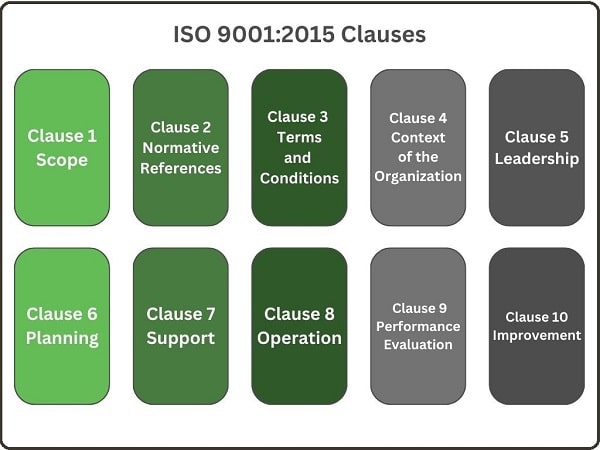
ISO 9001 Requirements
What are the ISO 9001 Clause Titles?
1. Scope
2. Normative References
3. Terms and Definitions
4. Context of the organization
5. Leadership
6. Planning
7. Support
8. Operation
9. Performance Evaluation
10. Improvement
Clause 1. Scope
Section 1 of the ISO 9001 standard, titled “Scope,” serves as an introductory section that defines the purpose and applicability of the standard. The overall purpose of Section 1 is to provide clarity and understanding regarding the scope of the ISO 9001 standard and its requirements.
Overall, Section 1 of the ISO 9001 standard serves as a foundational section that sets the stage for the subsequent clauses and requirements. It ensures that organizations and stakeholders clearly understand the standard’s scope and applicability, facilitating effective implementation of the QMS and alignment with ISO 9001 requirements.
Clause 2. Normative References
Section 2 of the ISO 9001 standard, titled “Normative References,” identifies and references other standards that are essential for the proper interpretation and implementation of ISO 9001. The overall purpose of this section is to provide a framework for organizations and auditors to understand and apply the referenced standards in conjunction with ISO 9001.
Clause 3. Terms and Definitions
Section 3 of the ISO 9001 standard, titled “Terms and Definitions,” serves the purpose of providing a common set of definitions and terminology that are used throughout the standard. The overall purpose of this section is to ensure consistent interpretation and understanding of the key terms and concepts used in ISO 9001.
Clause 4 Context of the Organization
Clause 4 of the ISO 9001 standard, titled “Context of the Organization,” establishes a comprehensive understanding of the organization and its operating environment. The overall purpose of this clause is to provide a foundation for developing and implementing a quality management system (QMS) that is aligned with the organization’s objectives and meets the needs of interested parties.
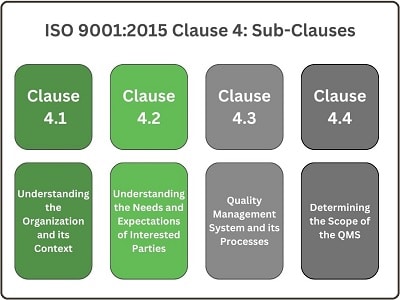
Clause 4 sets the stage for subsequent clauses in ISO 9001 and lays the foundation for developing, implementing, and continually improving a robust and effective QMS.
Clause 5 Leadership
Clause 5 of the ISO 9001 standard, titled “Leadership,” establishes the importance of leadership and top management’s commitment to driving the successful implementation of a quality management system (QMS). The overall purpose of this clause is to ensure that leadership within the organization plays a central role in promoting a culture of quality, setting strategic direction, and fostering continuous improvement.
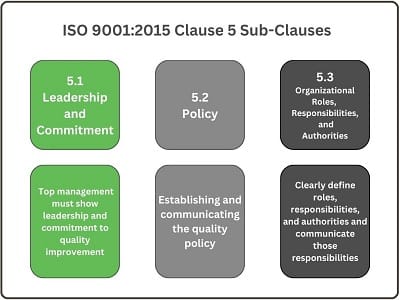
By addressing the objectives of Clause 5, organizations create a strong foundation for the successful implementation of their QMS.
Effective leadership ensures that quality is a strategic priority, and it provides the necessary support, resources, and direction to drive continuous improvement and achieve customer satisfaction.
Clause 5 emphasizes the importance of top management’s active involvement in shaping the organization’s quality culture and driving the QMS forward. It sets the tone for the organization’s commitment to quality and lays the groundwork for the subsequent clauses of ISO 9001.
Clause 6 Planning
Clause 6 of the ISO 9001 standard, titled “Planning,” serves the purpose of establishing a systematic approach to quality management system (QMS) planning within an organization. The overall purpose of this clause is to ensure that organizations identify and address the necessary actions to achieve their quality objectives, meet customer requirements, and continually improve their QMS.
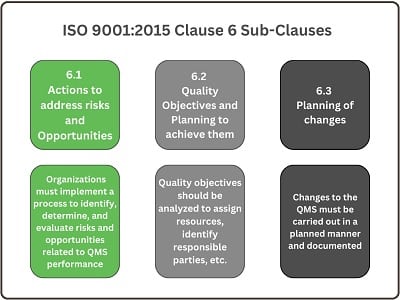
Clause 6 emphasizes the importance of a proactive approach to managing the QMS.
It provides organizations with a framework to establish clear objectives, define action plans, and allocate resources to achieve their quality goals.
Effective planning is critical to the successful implementation and ongoing effectiveness of the QMS, supporting the organization’s ability to consistently deliver products and services that meet customer requirements.
Clause 7 Support
Clause 7 of the ISO 9001 standard, titled “Support,” serves the purpose of establishing the necessary support mechanisms and resources for the effective implementation and maintenance of a quality management system (QMS). The overall purpose of this clause is to ensure that organizations have the necessary support structures in place to enable the achievement of quality objectives and the successful operation of the QMS.
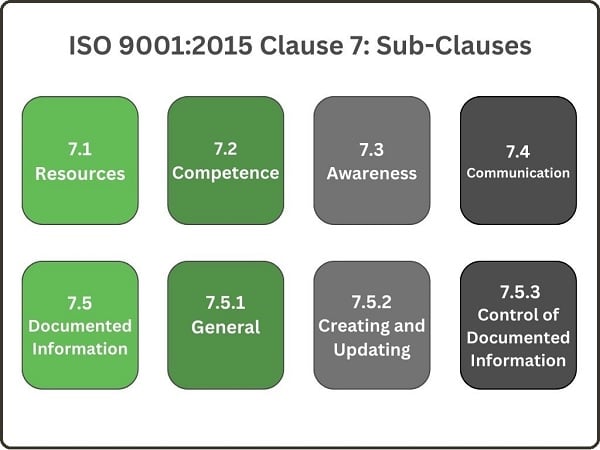
By addressing the objectives of Clause 7, organizations establish a solid foundation for the support of their QMS. The provision of resources, competent personnel, effective communication channels, and accurate documented information enables the smooth operation of the QMS.
Clause 7 highlights the importance of creating an environment where employees have the necessary resources and knowledge to contribute effectively to the QMS. It ensures that support structures are in place to enable the successful implementation and maintenance of the QMS, fostering a culture of quality and continuous improvement within the organization.
Clause 8 Operation
Clause 8 of the ISO 9001 standard, titled “Operation,” serves the purpose of outlining the requirements for the planning, execution, and control of the operational processes within a quality management system (QMS). The overall purpose of this clause is to ensure that organizations effectively carry out their processes and activities to deliver products and services that meet customer requirements and achieve the organization’s quality objectives.
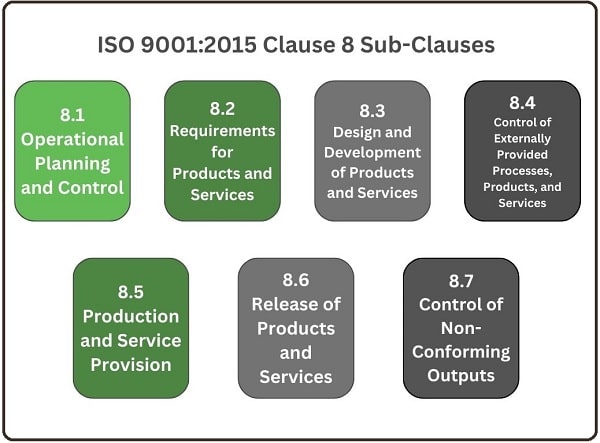
By addressing the objectives of Clause 8, organizations establish a systematic approach to planning, executing, and controlling their operational processes within the QMS.
This ensures that products and services are consistently delivered in accordance withby customer requirements, quality objectives, and applicable regulatory requirements.
Clause 8 focuses on the effective execution of processes, encompassing various activities such as planning, design, development (if applicable), production, service provision, and release. It aims to ensure that organizations have robust controls and measures in place to maintain product and service quality, prevent nonconformities, and continually improve their operational performance.
Clause 9 Performance Evaluation
Clause 9 of the ISO 9001 standard, titled “Performance Evaluation,” serves the purpose of establishing requirements for monitoring, measuring, analyzing, and evaluating the performance of a quality management system (QMS). The overall purpose of this clause is to ensure that organizations have effective processes in place to assess the performance of their QMS, identify areas for improvement, and make informed decisions based on objective data.
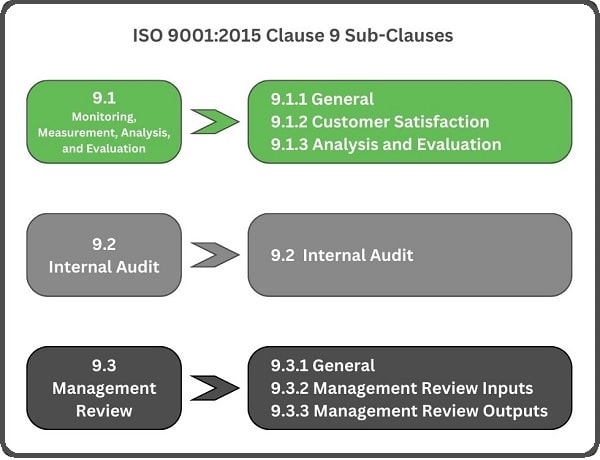
By addressing the objectives of Clause 9, organizations establish a framework for evaluating the performance and effectiveness of their QMS. The monitoring, measurement, analysis, and evaluation activities help organizations identify areas of improvement.
In addition, it helps to detect trends and take proactive actions to enhance their processes, products, and services.
Clause 9 emphasizes the importance of evidence-based decision-making and continual improvement. It ensures that organizations have mechanisms in place to gather relevant data, assess performance, identify areas of non-conformity, and implement corrective actions. By monitoring and evaluating the QMS, organizations can drive continual improvement, enhance customer satisfaction, and achieve their quality objectives.
Clause 10 Improvement
Clause 10 of the ISO 9001 standard, titled “Improvement,” serves the purpose of establishing requirements for continual improvement within a quality management system (QMS). The overall purpose of this clause is to ensure that organizations have processes in place to identify opportunities for improvement, take corrective actions to address non-conformities and drive ongoing enhancement of their QMS.
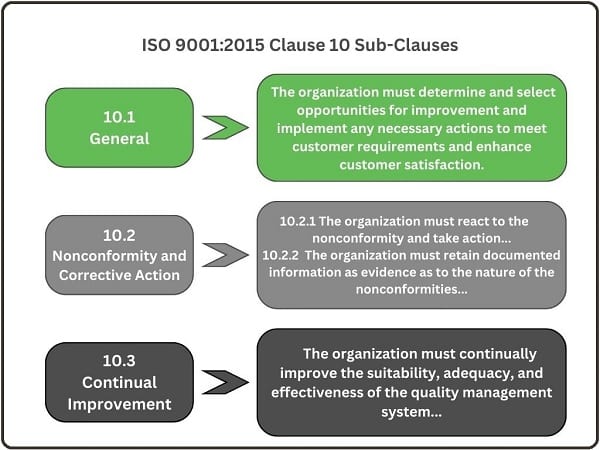
By addressing the objectives of Clause 10, organizations establish a framework for continual improvement within their QMS. The focus on nonconformity resolution, corrective actions, and ongoing enhancement ensures that organizations are proactive in addressing issues, driving efficiency, and delivering products and services that consistently meet customer requirements.
Clause 10 underscores the importance of a culture of continual improvement and guides how organizations can identify opportunities for enhancement. By promoting a systematic approach to analyzing data, implementing corrective actions, and managing change, organizations can foster a culture of innovation, responsiveness, and continuous learning, resulting in sustained business success and customer satisfaction.
ISO 9001:2015
ISO 9001:2015 is the latest version of the globally recognized quality management system (QMS) standard. Published by the International Organization for Standardization (ISO), this standard sets out the criteria for implementing an effective quality management system and achieving customer satisfaction.
Understanding ISO 9001:2015
ISO 9001:2015 is designed to be a flexible and adaptable standard applicable to organizations of all sizes and industries. It follows a high-level structure called Annex SL, which allows for easier integration with other management systems such as environmental management (ISO 14001) or information security management (ISO 27001).
The key changes in ISO 9001:2015 compared to its predecessor, ISO 9001:2008, include a greater emphasis on risk-based thinking, a focus on leadership engagement, increased flexibility in documentation requirements, and a stronger alignment with business objectives and strategic direction.
Key Features of ISO 9001:2015
Risk-Based Thinking:
ISO 9001:2015 introduces the concept of risk-based thinking throughout the standard. Organizations are required to identify and address risks and opportunities that could affect the achievement of quality objectives and the ability to provide consistent products and services that meet customer requirements.
Leadership and Commitment:
The standard places a strong emphasis on leadership and top management’s active involvement in the quality management system. Leaders are expected to establish a quality policy, define quality objectives, communicate the importance of meeting customer requirements, and ensure the availability of necessary resources.
Context of the Organization:
ISO 9001:2015 requires organizations to analyze their internal and external context, including interested parties and their requirements. This analysis helps organizations understand the factors that impact their QMS and enables them to develop strategies to address risks and opportunities effectively.
Process Approach:
The process approach is fundamental to ISO 9001:2015. Organizations are required to identify and manage their key processes, define their interactions, and ensure that activities are carried out as planned. This approach enhances efficiency, effectiveness, and consistency in delivering products and services.
Documentation and Control:
ISO 9001:2015 provides greater flexibility in documentation requirements compared to its previous version. Organizations are encouraged to determine the level of documentation necessary based on the size, complexity, and nature of their operations. The standard emphasizes the importance of controlling documented information to ensure its accuracy, availability, and proper use.
ISO 9001:2015 vs. ISO 9001:2008: Understanding the Key Differences
ISO 9001 is an internationally recognized standard for quality management systems (QMS) that provides organizations with guidelines for implementing effective quality practices. In 2015, ISO updated the standard to ISO 9001:2015, replacing the earlier ISO 9001:2008 version.
Structure and Terminology:
One notable change in ISO 9001:2015 is the adoption of the high-level structure called Annex SL. This structure aligns ISO 9001 with other management system standards, such as ISO 14001 for environmental management and ISO 27001 for information security management. The adoption of a common structure enhances compatibility, integration, and consistency across different management systems.
Additionally, ISO 9001:2015 introduces new terminology. The term “product” in ISO 9001:2008 is replaced with “product and services” in ISO 9001:2015 to reflect the broader scope of the standard and its applicability to service-oriented organizations.
Context of the Organization:
ISO 9001:2015 places a stronger emphasis on understanding the organization’s context, both internal and external, to determine the scope of the quality management system. Organizations are required to identify interested parties, their needs and expectations, and the internal and external factors that can impact the QMS and the ability to achieve desired outcomes.
This shift encourages organizations to take a holistic approach to quality management, considering the broader context in which they operate. It helps organizations align their quality objectives with their strategic direction and focus on the factors that truly matter to their customers and stakeholders.
Risk-Based Thinking:
ISO 9001:2015 introduces a significant change by incorporating risk-based thinking throughout the standard. Organizations must identify risks and opportunities that could impact their ability to meet customer requirements and quality goals.
The inclusion of risk-based thinking encourages organizations to take a proactive approach to risk management. It calls for the identification, assessment, and mitigation of risks through effective controls and preventive measures. By integrating risk management into the quality management system, organizations can minimize negative outcomes, seize opportunities, and enhance overall performance.
Leadership and Commitment:
ISO 9001:2015 places a greater emphasis on leadership engagement and commitment. Top management is expected to demonstrate active involvement in the QMS, ensuring that quality objectives are established, communicated, and aligned with the organization’s strategic direction.
Leadership is also responsible for promoting a culture of quality throughout the organization, engaging employees at all levels, and allocating necessary resources to support the QMS. This focus on leadership involvement underscores the importance of a top-down approach in driving quality excellence.
Documentation:
ISO 9001:2015 introduces a more flexible approach to documentation requirements. Unlike ISO 9001:2008, which prescribed specific documented procedures and a quality manual, ISO 9001:2015 allows organizations to determine the necessary documentation based on their needs and the complexity of their processes.
The focus is on keeping documentation that is relevant, accurate, and needed for the QMS to run effectively.
Organizations can choose how to document processes, instructions, and records, as long as they can show they meet the standard’s requirements.
Emphasis on Performance Evaluation:
ISO 9001:2015 reinforces the importance of monitoring, measuring, and evaluating performance. Organizations are required to establish key performance indicators (KPIs) that are aligned with their quality objectives and monitor them regularly.
The standard encourages a data-driven approach, where organizations gather and analyze relevant information to assess the effectiveness of the QMS, identify areas for improvement, and make evidence-based decisions. Organizations must set key performance indicators (KPIs) that match their quality goals and monitor them regularly.
ISO 9001:2015 brings significant updates and enhancements to the previous version, ISO 9001:2008. The adoption of a common structure, emphasis on risk-based thinking, enhanced leadership involvement, flexible documentation requirements, and focus on performance evaluation reflect the evolving needs and expectations of organizations in managing quality effectively. By embracing the changes introduced in ISO 9001:2015, organizations can strengthen their quality management practices and drive continuous improvement in today’s dynamic business environment.
Previous Versions of ISO 9001
A Journey Through the Previous Versions of ISO 9001: Evolution of Quality Management
ISO 9001 is a globally recognized standard for quality management systems (QMS) that has undergone several revisions and updates since its inception. Each version of the standard reflects the changing landscape of quality management practices and the evolving needs of organizations. In this article, we will take a journey through the previous versions of ISO 9001, exploring their key features and the progression of quality management over the years.
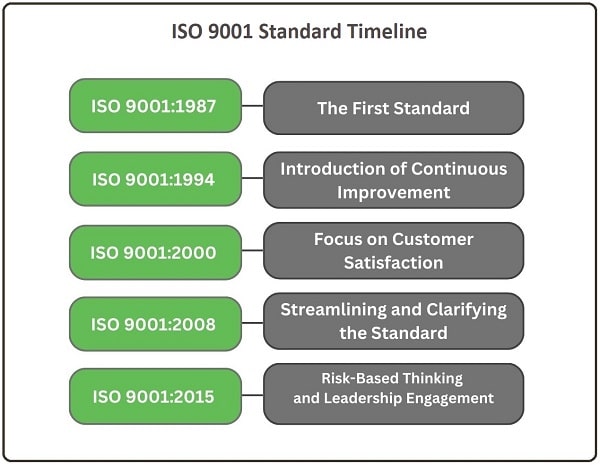
ISO 9001:1987 – The First Standard
The first version of ISO 9001 was published in 1987 and established the foundation for subsequent iterations. This initial release focused on documenting quality management systems and ensuring compliance with specified procedures. The standard emphasized the importance of quality control and meeting customer requirements but did not explicitly address continuous improvement.
ISO 9001:1994 – Introduction of Continuous Improvement
The 1994 revision introduced the concept of continuous improvement and emphasized the importance of preventive actions. It emphasized a process-based approach, where organizations identified and managed their key processes to deliver consistent quality. ISO 9001:1994 also incorporated the Plan-Do-Check-Act (PDCA) cycle, providing a framework for organizations to drive continual improvement in their quality management practices.
ISO 9001:2000 – Focus on Customer Satisfaction
The year 2000 brought significant changes to ISO 9001. This version shifted the focus from compliance with documented procedures to achieving customer satisfaction. It emphasized the need for organizations to understand and meet customer requirements, enhance customer satisfaction, and measure customer perception. ISO 9001:2000 introduced the concept of process performance measurement and management review to ensure the ongoing effectiveness of the QMS.
ISO 9001:2008 – Streamlining and Clarifying the Standard
In 2008, ISO 9001 underwent a revision to streamline and clarify the standard. The changes in ISO 9001:2008 were primarily editorial in nature and did not introduce any new requirements. The revisions focused on enhancing clarity, improving compatibility with other management system standards, and ensuring consistency in interpretation.
ISO 9001:2015 – Embracing Risk-Based Thinking and Leadership Engagement
The most recent version of ISO 9001, published in 2015, brought significant changes to the standard. ISO 9001:2015 adopted a high-level structure called Annex SL, which provides a common framework for various management system standards. This structure enables easier integration and alignment of different management systems.
ISO 9001:2015 introduced a more holistic approach to quality management, emphasizing the context of the organization and risk-based thinking. Organizations are required to consider their internal and external context, identify interested parties and their requirements, and assess risks and opportunities that could affect the QMS and its objectives. The standard also places a stronger emphasis on leadership engagement, strategic direction, and performance evaluation.
The Future of ISO 9001
ISO 9001:2015 is the latest version of the standard. However, ISO standards are subject to periodic revisions to reflect emerging trends, best practices, and evolving business environments. Organizations must stay updated on future revisions and adapt their quality management practices accordingly.
The journey through the previous versions of ISO 9001 showcases the evolution of quality management over the years. From focusing on compliance with documented procedures to embracing risk-based thinking, customer satisfaction, and leadership engagement, each version has contributed to the continuous improvement of quality management practices. ISO 9001 remains a vital tool for organizations seeking to enhance their quality management systems and achieve excellence in meeting customer expectations.
What is a Quality Management System?
Understanding the Essence of a Quality Management System
In today’s fast-paced and competitive business landscape, delivering high-quality products and services is essential for organizations to thrive. To ensure consistency, efficiency, and customer satisfaction, companies employ a systematic approach known as a Quality Management System (QMS). Here we delve into the concept of a QMS, its key components, and its significance in driving organizational success.
Defining a Quality Management System:
A Quality Management System is a set of interconnected processes, procedures, policies, and resources that an organization implements to manage and enhance the quality of its products or services. It serves as a framework for establishing and maintaining quality objectives, ensuring compliance with applicable standards and regulations, and continuously improving performance.
A comprehensive QMS typically encompasses the following key components:
1. Documentation:
A QMS relies on clear, well-defined documentation that includes quality policies, procedures, work instructions, specifications, and records. These documents serve as a guide for employees, outlining the steps to be followed to achieve consistent quality outcomes.
2. Processes and Procedures:
A QMS establishes standardized processes and procedures across the organization, ensuring that work is conducted consistently and controlled. These processes cover various areas such as design and development, purchasing, production, testing, customer service, and more.
3. Risk Management:
A QMS incorporates risk management principles to identify and mitigate potential risks that could impact product quality or customer satisfaction. It involves assessing risks, implementing controls, and continuously monitoring and reviewing risks to minimize their impact.
4. Performance Monitoring:
Monitoring and measuring performance is an integral part of a QMS. It involves setting quality objectives, establishing key performance indicators (KPIs), collecting data, analyzing trends, and evaluating performance against targets. This data-driven approach enables organizations to identify areas for improvement and make informed decisions.
5. Corrective and Preventive Actions:
When non-conformities or deviations from quality standards occur, a QMS emphasizes the importance of taking corrective and preventive actions. Corrective actions address immediate issues and eliminate the root causes of problems, while preventive actions proactively prevent the recurrence of issues.
6. Continuous Improvement:
A QMS fosters a culture of continuous improvement, encouraging employees to contribute ideas, suggest enhancements, and participate in improvement initiatives. This iterative approach drives ongoing advancements in processes, products, and services, resulting in increased customer satisfaction and operational efficiency.
The Significance of a QMS:
Implementing a QMS offers numerous benefits for organizations, including:
1. Consistency and Standardization:
A QMS establishes consistent processes and procedures, reducing variations and ensuring that products or services meet predefined quality requirements. This consistency enhances customer confidence and trust in the organization’s ability to deliver reliable results.
2. Customer Satisfaction:
By focusing on customer needs and expectations, a QMS enables organizations to consistently deliver products or services that meet or exceed customer requirements. This customer-centric approach leads to higher satisfaction levels, increased loyalty, and positive word-of-mouth recommendations.
3. Compliance and Risk Management:
A QMS helps organizations comply with applicable regulations, industry standards, and customer-specific requirements. It incorporates risk management practices to identify and mitigate potential risks, protecting the organization from quality-related issues, legal repercussions, and reputational damage.
4. Continuous Improvement:
With a QMS in place, organizations are better equipped to identify areas for improvement and implement effective corrective and preventive actions. By constantly enhancing processes, addressing nonconformities, and embracing innovation, organizations can stay ahead of the competition and adapt to changing market dynamics.
5. Operational Efficiency:
A QMS streamlines processes, eliminates waste, and optimizes resource utilization, leading to improved operational efficiency and cost-effectiveness. By identifying bottlenecks, reducing rework, and enhancing productivity,
Examples of a QMS
A Quality Management System (QMS) is a comprehensive framework that helps organizations establish and maintain consistent quality standards in their operations. Here are some examples of components commonly found in a QMS:
1. Document Control:
Implementing a document control system ensures that all relevant documents, such as policies, procedures, work instructions, and forms, are properly documented, controlled, and easily accessible. It includes version control, document approval processes, and document distribution to relevant personnel.
2. Risk Management:
An effective QMS incorporates risk management practices to identify and assess potential risks that may impact product quality, customer satisfaction, or business operations. It involves conducting risk assessments, implementing risk mitigation strategies, and continuously monitoring and reviewing risks.
3. Supplier Management:
Organizations rely on suppliers to provide goods and services that meet their quality requirements. A QMS includes processes for evaluating and selecting suppliers, establishing quality criteria, monitoring supplier performance, and addressing non-conformities or issues related to supplied products or services.
4. Training and Competence:
Ensuring that employees are competent and possess the necessary skills and knowledge is essential for maintaining consistent quality. A QMS includes procedures for identifying training needs, providing relevant training programs, assessing employee competence, and maintaining records of training activities.
5. Corrective and Preventive Actions:
When quality issues or non-conformities arise, a QMS incorporates processes for addressing them. Corrective actions focus on eliminating the root causes of problems, while preventive actions aim to identify and mitigate potential issues before they occur. These actions involve investigating non-conformities, implementing corrective measures, and tracking their effectiveness.
6. Auditing and Monitoring:
Regular internal and external audits play a crucial role in a QMS. Internal audits assess compliance with quality standards, identify areas for improvement, and ensure that processes are being followed. External audits by certification bodies validate the organization’s adherence to relevant standards and regulations.
7. Continuous Improvement:
Continuous improvement is a fundamental principle of a QMS. It involves establishing mechanisms for collecting and analyzing data, setting quality objectives and targets, implementing improvement projects, and monitoring progress. Examples include process performance metrics, customer feedback analysis, and the use of improvement methodologies like Lean or Six Sigma.
8. Customer Satisfaction and Feedback:
A QMS places a strong emphasis on understanding customer needs, expectations, and satisfaction levels. It includes mechanisms for collecting customer feedback, addressing complaints, tracking customer satisfaction metrics, and implementing actions to improve customer experience.
9. Management Review:
Regular management reviews are conducted as part of a QMS to evaluate the performance and effectiveness of the system. These reviews involve analyzing quality metrics, reviewing non-conformities and corrective actions, setting improvement objectives, and allocating resources for QMS enhancement.
10. Measurement and Analysis:
A QMS includes procedures for collecting and analyzing data related to quality performance, process capability, and customer satisfaction. This data-driven approach enables organizations to identify trends, make informed decisions, and take proactive measures to improve quality.
These examples highlight the key components of a QMS, but it’s important to note that the specific elements may vary depending on the organization’s industry, size, and unique requirements. The QMS should be tailored to meet the organization’s specific needs and align with relevant quality standards and regulations.
How much does ISO 9001 Certification cost?
Well, we can’t speak for anyone else, but the pricing for ISO 9001 certification with The Core Solution, Inc. varies based on the organization’s size and complexity. Our pricing structure is transparent and determined by the number of employees in the organization. The preparation costs range from $5,700 to $15,000, while the certification costs range from $3,000 to $5,000. The actual costs depend on the company size and the duration of the preparation period chosen.
Besides the certification costs, there are additional expenses associated with achieving ISO 9001 certification. These may include training employees in the standard’s requirements and conducting internal audits to ensure compliance. However, the advantages of ISO 9001 certification typically outweigh the costs. Certification helps organizations enhance their operations, lower expenses, boost customer satisfaction, and improve their reputation.
Helpful ISO 9001:2015 YouTube Videos:
What is ISO 9001- ISO 9001 Explained
How Long does ISO 9001 Really Take? Avoid these 3 Mistakes
ISO Compliance vs Certification | Which Is Right For You?
What is Risk-Based Thinking? [How To: ISO 9001]
ISO 9001 for Small Business? | ISO 9001 Certification Explained
Helpful ISO 9001:2015 Articles
3 Steps to ISO 9001 Certification – 2023 Update
ISO Compliance VS. Certification – 2023 Update
What’s really required for a Small Business to get ISO 9001 Certification? Part 1 – 2023 Update
What’s really required for a Small Business to get ISO 9001 Certification? Part 2 – 2023 Update
Helpful ISO 9001:2015 Podcasts:
The Quality Hub: Episode 1 – Kickoff For Quality
The Quality Hub: Episode 2 – Planning Your QMS
The Quality Hub: Episode 3 – From Planning to Implementation
The Quality Hub: Episode 4 – Putting It All Together
The Quality Hub: Episode 5 – Reviewing Your Progress
The Quality Hub: Episode 6 – The Internal Audit Process
The Quality Hub: Episode 7 – Your Certification Audit
The Quality Hub: Episode 8 – Life After the Audit
Consulting Support for ISO 9001
Every year, we help hundreds of small businesses achieve ISO 9001 certification. Support for ISO 9001 is available through any of our Consulting Programs
As an American business with a story like yours, we know that time is valuable. Our expert consultants are here to take on the difficult, technical aspects of certification so you can focus on your business. They’ll work with you every step of the way until you’re successfully certified.
Interested? Get a Free Quote.
In many industries, ISO 9001 has become a supply-chain requirement. When landing a big contract, ISO 9001 certification could make all the difference.
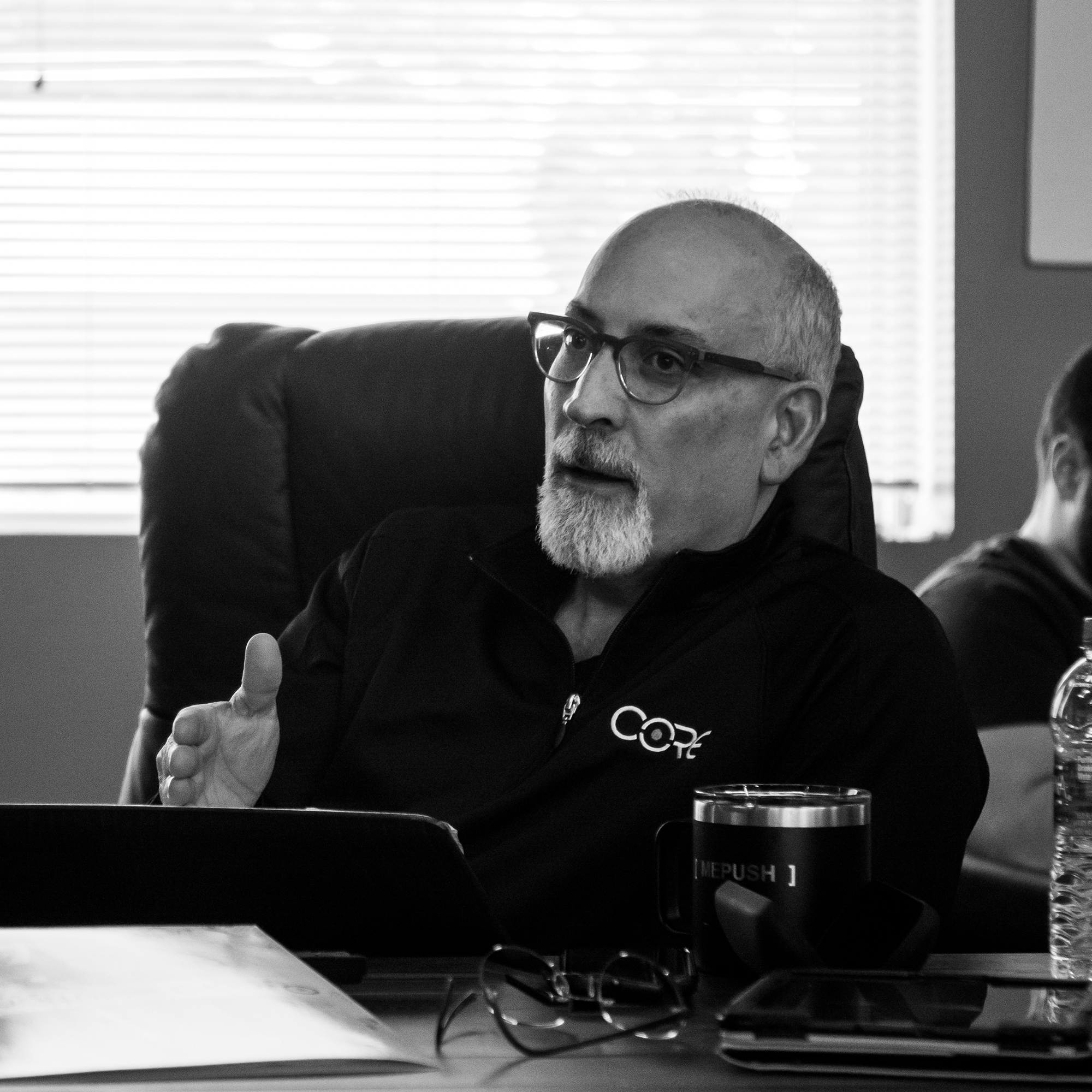
About Core Business Solutions
"Core Business Solutions was started by my brother, Mike Dawson, and myself, true entrepreneurs at heart looking for a better way to make a living and help small businesses improve the quality of the products and services they provide.
The bottom line: we are real people that have developed a team to come along side you to help you grow and succeed."
-- Scott Dawson, President
Related Standards
We provide consulting support for various other standards, as well as support for companies seeking multiple certifications through an Integrated Management System.
AS9100
Aerospace Manufacturers
AS9120
Aerospace Distributors
ISO 14001
Environmental Management Systems
ISO 27001
Information Security Management Systems
ISO 20000-1
Service Management Systems
ISO 45001
OH&S Management Systems
ISO 13485
Medical Device Manufacturers
AS9100
AS9120
ISO 14001
ISO
20000-1
ISO 27001
ISO 45001
ISO 13485
Equip Your Business to Meet ISO 9001 With CORE
At Core Business Solutions, we’re here to equip your company for success in meeting ISO 9001 requirements. We’ve helped hundreds of small businesses grow and deliver the best solutions to their clients. We provide ISO training services, consulting help, and compliance software and to help you get certified and stay certified. We focus on optimizing your processes and helping you implement an ISO-compliant QMS. When you partner with us, you’ll get the tools and help you need for success.
For more information on the ISO 9001:2015 standard, please visit our articles page. You can also call our consulting office at 866-354-0300.
